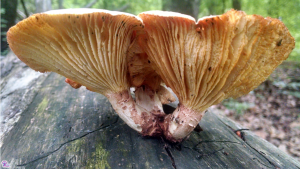Fungus Fact List (Plain)
#001: Armillaria ostoyae, the Humongous Fungus
#004: Fungal Hyphae Are Not Made Up of Traditional Cells
#005: Xylaria polymorpha, Dead Man’s Fingers
#007: Omphalotus illudens, The Jack-O-Lantern Mushroom
#009: Overview of the Fungal Life Cycle
#011: Characteristics of Fungi
#012: Characteristics of Phylum Ascomycota
#013: Characteristics of Division Basidiomycota
#014: Characteristics of Phylum Chytridiomycota
#015: Characteristics of Division Glomeromycota
#016: Characteristics of the Defunct Phylum Zygomycota
#017: Characteristics of Phylum Microspora
#018: Characteristics of the Phyla Blastocladiomycota and Neocallimastigomycota
#019: Apiosporina morbosa, Black Knot
#020: Aleurodiscus oakesii, Smooth Patch Disease
#021: Pleurotus ostreatus, The Oyster Mushroom
#023: Tremella fuciformis, the Snow Fungus
#024: Fungi in the Production of Chocolate
#026: Pseudogymnoascus destructans
#027: Gilled Mushrooms (Agarics)
#028: Mushroom Morphology: Boletes
#029: Mushroom Morphology: Chanterelles and Trumpets
#030: Mushroom Morphology: Polypores
#031: Mushroom Morphology: Toothed Fungi
#032: Mushroom Morphology: Cup Fungi
#033: Mushroom Morphology: Morels
#034: Mushroom Morphology: False Morels
#035: Mushroom Morphology: Elfin Saddles
#036: Mushroom Morphology: Earth Tongues
#037: Mushroom Morphology: Earth Tongue Look-Alikes
#038: Mushroom Morphology: Corals and Clubs
#039: Mushroom Morphology: Crust Fungi
#040: Mushroom Morphology: Stinkhorns
#041: Mushroom Morphology: Puffballs
#042: Mushroom Morphology: Earthballs
#043: Mushroom Morphology: Bird’s Nest Fungi
#044: Mushroom Morphology: Earthstars
#045: Mushroom Morphology: Sequestrate Fungi
#046: Mushroom Morphology: False Truffles
#047: Mushroom Morphology: Truffles
#048: Mushroom Morphology: Jelly Fungi
#050: The Destroying Angels, Amanita virosa Species Group
#051: The Death Cap, Amanita phalloides
#052: The Indigo Milk Mushroom, Lactarius indigo
#054: Oomycota (Water Molds and Downy Mildews)
#055: The Old Man of the Woods, Strobilomyces floccopus
#056: Artomyces pyxidatus, The Crown-Tipped Coral Fungus
#057: Hygrocybe conica, The Witch’s Hat
#058: Cordyceps militaris: the Scarlet Caterpillar Club
#059 Tremella mesenterica, Witch’s Butter
#060: Urnula craterium, The Devil’s Urn
#061: Ergot of Rye, Claviceps purpurea
#062: Overview of Lichens, Part 1: Biology and Morphology
#063: Overview of Lichens, Part 2: Ecology and Impact
#064: Endangered Fungal Species
#065: Trametes versicolor, The Turkey Tail
#067: Mushroom Morpholgy: Verpas
#068: Frosty Pod Rot Disease of Cacao Trees
#069: Amanita muscaria, Part 1: The Type Mushroom
#070: Ganoderma applanatum, The Artist’s Conk
#071: Flammulina velutipes, The Velvet Foot or Enoki
#072: Leucocooprinus birnbaumii, The Yellow Houseplant Mushroom
#078: Evolution of Mycorrhizae
#079: Tips on Mushroom Collection
#080: Flavoparmelia caperata, The Common Greenshield Lichen
#081: Phellinus robiniae, the Cracked Cap Polypore
#082: Biscogniauxia atropunctata
#083: Hypomyces lactifluorum: The Lobster Mushroom
#085: Schizophyllum commune, The Mushroom with Over 28,000 Sexes
#086: Morchella esculentoides, a Yellow Morel
#087: Gymnosporangium juniperi-virginianae, Cedar-Apple Rust
#089: Cerioporus squamosus, the Dryad’s Saddle
#092: Gyromitrin and Monomethylhydrazine (MMH)
#096: The Great Famine of Ireland and Phytophthora infestans
#097: Ibotenic Acid and Muscimol
#099: Gastrointestinal Irritants
#100: Uncommon Mushroom Toxins
#102: The Chicken of the Woods or Sulfur Shelf Fungus
#103: Grifola frondosa, The Hen of the Woods
#104: Hydnum repandum, the Hedgehog Mushroom
#105: Pseudohydnum gelatinosum, The Toothed Jelly Fungus
#106: Calostoma cinnabarinum, the Stalked Puffball-In-Aspic
#107: The Banana and Fusarium oxysporum f. sp. cubense
#108: Heimioporus betula, the Shaggy-Stalked Bolete
#109: Rubroboletus satanas, Satan’s Bolete or Devil’s Mushroom
#110: Alectoria sarmentosa, Witch’s Hair
#111: Stemonitis spp., Chocolate Tube Slime Molds or Tree Hair
#112: Monotropa uniflora, Ghost Plant, Indian Pipe, or Corpse Plant
#113: Moniliophthora perniciosa, Witches’ Broom Disease of Cacao Trees
#114: Hericium erinaceus, the Lion’s Mane, Bearded Tooth, or Pom Pom Blanc Mushroom
#115: Neotyphodium coenophialum, Tall Fescue Endophyte
#117: Craterellus cornucopioides species group, the Horn of Plenty
#118: Poronidulus conchifer, the Little Nest Polypore
#119: Pisolithus arrhizus, the Dyeball
#121: Amanita muscaria, Part 2: Connecting to the Divine
#122: Sphaerobolus stellatus, the Artillery Fungus
#124: Galerina marginata, the Deadly Galerina
#125: Hypholoma sublateritium, the Brick Cap
#126: Xylobolus frustulatus, the Ceramic Fungus
#127: Ophidiomyces ophiodiicola, causal agent of Snake Fungal Disease
#129: Phellinus igniarius and its use as a Tobacco Additive
#130: Order Pucciniales, the Rust Fungi
#131: Class Ustilaginomycetes, Smut Fungi
#132: Microbotryum spp., the Anther Smuts
#133: Russula virescens species group
#134: Auricularia auricula-judae, the Jelly Ear Mushroom
#135: Hymenoscyphus fraxineus, Ash Dieback Disease
#136: Inonotus obliquus, Chaga Mushroom
#137: Sarcoscypha dudleyi, S. austriaca, and S. coccinea, the Scarlet Cups
#138: Gyromitra esculenta, a False Morel
#139: Disciotis venosa, the Bleach Cup
#140: Morchella angusticeps, the Black Morel of Eastern North America
#141: Pilobolus spp., the Hat Throwers
#142: Pluteus cervinus, the Deer Mushroom
#143: Boletinellus merulioides, the Ash Tree Bolete
#144: Stereum ostrea, the False Turkey Tail
#145: Byssomerulius incarnatus, the Coral-Pink Merulius
#146: Gliophorus psittacinus, the Parrot Mushroom
#148: Cladonia cristatella, British Soldier Lichen
#149: Haploporus odorus, the Diamond Willow Fungus or Aniseed Polypore
#150: Asterophora lycoperdoides
#151: Cantharellus cinnabarinus, the Cinnabar-Red Chanterelle
#152: Amanita rubescens Group, The Blushers
#152: Amanita rubescens, The Blusher
#155: Microglossum viride, the Green Earth Tongue
#156: Calvatia gigantea, the Giant Puffball
#158: Hypomyces chrysospermus, the Bolete Eater
#160: Suillus luteus, the Slippery Jack
#161: Opportunistic Fungal Infections
#163: Valley Fever, Coccidioidomycosis
#165: Fistulina hepatica, the Beefsteak Fungus
#166: Chlorociboria spp., Green Stain Fungi
#178: The Family Gomphidiaceae
#181: Chlorophyllum molybdites
#183: The Family Entolomataceae
#187: Phylloporus rhodoxanthus, the Gilled Bolete
#188: Leotia lubrica, Jelly Babies
#189: Fomes fomentarius, The Tinder Polypore
#192: Coprinellus micaceus, The Mica Cap
#193: Stropharia rugosoannulata, The Wine Cap
#194: Spathulariopsis velutipes
#195: Warfarin, from Cow Disease to Medicine
#196: Hygrophoropsis aurantiaca, The False Chanterelle
#197: Tolypocladium ophioglossoides, The Golden Thread Cordyceps
#199: Entoloma abortivum, The Aborting Entoloma
#200: Gyroporus castaneus, The Chestnut Bolete
#201: Phaeolus schweinitzii, The Dyer’s Polypore
#209: Gyromitra caroliniana, Big Red
#210: Aleuria aurantia, the Orange Peel Fungus
#212: Galiella rufa, The Peanut Butter Cup Fungus
#214: Coprinellus disseminatus
#215: Camarops petersii, The Dog’s Nose Fungus
#217: Scleroderma citrinum, The Pigskin Poison Puffball
#218: Neolentinus lepideus, The Train Wrecker
#222: Cryphonectria parasitica, Chestnut Blight
#223: Lepista nuda, The Blewit
#224: Pythium insidiosum, Pythiosis
#225: Radulodon copelandii, The Asian Beauty
#227: Polyporus umbellatus, the Umbrella Polypore






![#011: Characteristics of Kingdom Fungi [Archived]](https://www.fungusfactfriday.com/wp-content/themes/hueman/assets/front/img/thumb-small-empty.png)

